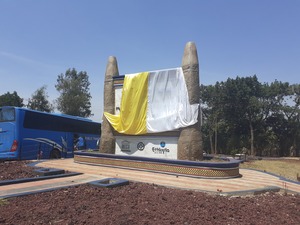Gedeo Cultural landscape

The Gedeo cultural landscape represents the traditional agroforestry practices of the indigenous Gedeo community.
The Gedeo have used the forests for millennia for the cultivation of enset (a plant that is the ingredient for a staple flatbread) and later coffee. They developed a system of customary laws and norms to use the forests sustainably. The area also includes ritual sites such as megalithic clusters of steles.
Community Perspective: Wojciech visited 3 places of interest in early 2024.
Map of Gedeo Cultural landscape
Community Reviews
Thomas Buechler
Chelba-Tututi was the cemetery we visited after reading Woijtek’s recommendations. It is in the tiny village of Koti, about 40 minutes south of Dila. The guide was excellent; only men are buried here under phallus shaped stellas, they were recording 1506 pieces scattered allover, very few have inscriptions. British and a German anthropologist have unearthed in 1994 and 2011 gold bracelets and pottery. For circumcised men, it was customary to be buried with two.
Wojciech Fedoruk

Site visited in January 2024 as a family trip.
The Gedeo cultural landscape is a recent entry on the UNESCO list, located in a very fertile place, on the slopes of the Rift Valley. The area is green even in the dry season, almost everything is grown here - from coffee to tropical fruits to potatoes and grain.
The area is inhabited by the Gedeo people, who are said to have created unique rules for coexistence and use of natural resources. It's hard to tell when you're there, because the place is currently completely neglected when it comes to serving visitors. Fortunately, the state party provided a comprehensive map of places of interest, so we had a starting point. And on the main road from Hawassa to the Kenyan border there are signs to specific places of interest.
We visited three of the places indicated by the state party,: Tuto-Fela, Chelba-Tutiti and Birbirota Sacred Forest.
Tuto-Fela is an ancient cemetery with dozens of well-preserved stelae, some of which are additionally decorated. The place is located about 5 km from the main road and it is not easy to get there, but it has a normal ticket office and a "guide". I write in quotation marks on purpose, because ours couldn't say much. He also did not know the age of the stelae, because I don't really believe it was built in the 1st century AD. He only indicated that the graves were women's, and the highest stele belonged to the bravest of them. This place is not particularly popular with tourists, we were the biggest attraction of the place, constantly surrounded by a crowd of children and even some adults.
The mystery of the women's graves was solved at the next site we went to, the Chelba-Tututi cemetery a few kilometers further south. Chelba-Tutiti is located 3 km from the main road and is ahead of its counterpart in Tuto-Fela in almost every respect. It is much bigger and nicer, the steles are much more powerful. Maybe it's because men were buried here. This was probably the first place in the world I visited where women and men were buried in completely different places.
We were also greeted at Chelba-Tutiti by a much more knowledgeable guide. Thanks to it, we learned, among other things, that the two frames on the top of the stele represent an adult man (or more precisely, one capable of marriage), and one - a child. He explained the characteristic drawing on one of the stelae as a symbol of a chest, which was supposed to symbolize courage. He also showed us how to get to the last place we wanted to visit. And here we were probably accompanied by all the children from the village.
From Chelba-Tutiti we went to Birbirota Sacred Forest, but there was absolutely no one there who could explain anything to us. We made a short hike, but the sacred forest looked nothing like a normal forest to us.
To sum up, this WHS is definitely interesting but needs better interpretation.
How to visit: A good base is neighbouring Dila, which has decent hotels. To visit all the components, you probably need full day. Not sure if 4x4 is necessary, but definitely recommended.
Community Rating
Site Info
- Full Name
- The Gedeo Cultural landscape
- Unesco ID
- 1641
- Country
- Ethiopia
- Inscribed
- 2023
- Type
- Cultural
- Criteria
-
3 5
- Categories
- Cultural Landscape - Continuing
- Link
- By ID
Site History
2023 Advisory Body overruled
ICOMOS suggested immediately inscribing In Danger. Overturned by amendment from Qatar.
2023 Inscribed
2021 Incomplete - not examined
2020 Revision
Successor to "Gedeo Mixed Cultural and Natural Landscape" (2012)
Site Links
Unesco Website
Connections
The site has 9 connections
Constructions
History
Human Activity
Religion and Belief
Timeline
Trivia
Visitors
12 Community Members have visited.
The Plaque
 (photo by Jarek)
(photo by Jarek)